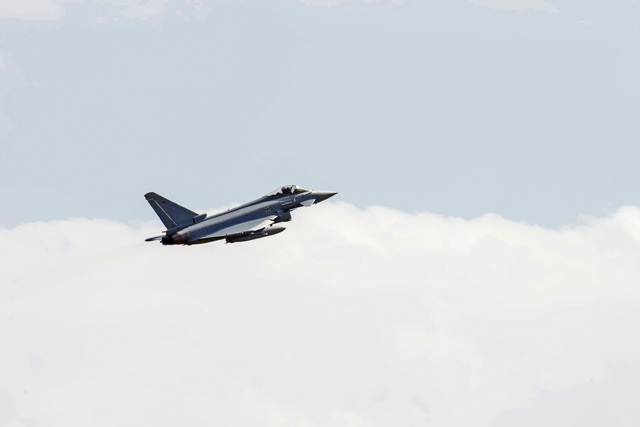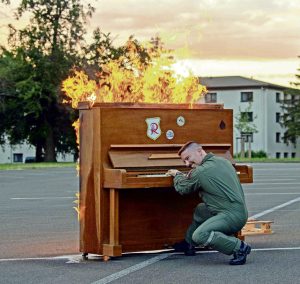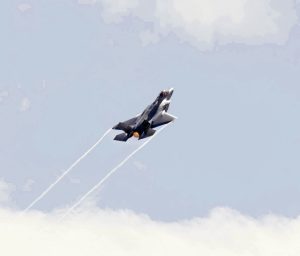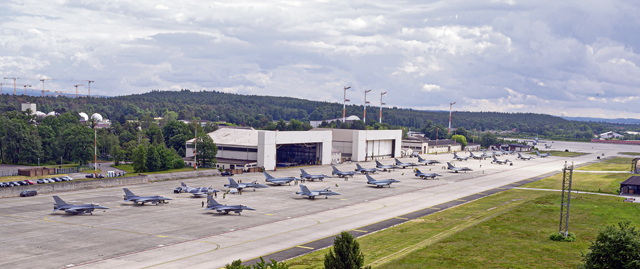
Thirty-seven fighter jets from nine NATO countries participated in Ramstein 1v1, U.S. Air Forces in Europe’s first-ever basic fighter maneuvers exercise at Ramstein Air Base, June 6.
Participants included military aviators from the U.S., United Kingdom, Norway, Netherlands, Belgium, Denmark, Finland, France and Germany. Aircraft included F-35A Lightning IIs, F-16 Fighting Falcons, Eurofighter Typhoons, Dassault Rafale Cs, F/A-18 Hornets and Douglas A-4 Skyhawks.
During the exercise, aviators engaged in a friendly match of basic fighter maneuvers to test their rapid decision-making and precise reactions to adversary maneuvers in a high-pressure, demanding setting — an essential skill for fighter pilots.

“Basic fighter maneuvering — sometimes called dogfighting — is a foundational skill set for fighter pilots,” said Lt. Col. Michael Loringer, U.S. Air Forces in Europe – Air Forces Africa chief of weapons and tactics. “It tests a pilot’s reaction time, physical stamina and situational awareness. BFM is a coveted and timeless skillset, dating back to the first fighter pilots of World War I. There is no better way to build trust in a pilot’s aircraft or a pilot’s skills than to engage in a one on one BFM fight.”
In addition to providing an opportunity to test their skills in a unique setting, the exercise bolstered relationships and esprit de corps among Allies through the sharing of tactics, techniques and experiences – ultimately strengthening NATO’s collective resolve. Additionally, it allowed the U.S. and Allies to learn from one another and foster teamwork in a safe environment, enhancing communication and interoperability.
“This event provided a prime opportunity to hone our skills, and it made a fun experience to build cooperation and camaraderie amongst all the participants,” Lorringer said. “We are not just NATO Allies, but a community bound by genuine friendship and respect. I emphasize this point because successful military operations require exceptional teamwork, often critical to survival. And as a pilot, it boils down to trust. It’s crucial to trust your wingman.”
Further demonstrating the trust and teamwork demonstrated during Ramstein 1v1, U.S. Airmen from Lakenheath Air Base serviced Royal Norwegian Air Force F-35A Lightning II aircraft, a force multiplier for U.S. national security and NATO’s unified, collective defense, Loringer said.

At the core of the Global Gateway, 86th Airlift Wing personnel also provided installation support to ensure the exercise was a success.
“This exercise is about preparation and being ready to deploy and project our airpower throughout Europe and Africa at a moment’s notice,’ said Airman Basic Regis Dickerson II, 86th Logistic Readiness Squadron mobile distribution operator. “The stronger our trust and connections becomes, the stronger our capabilities become. When we join together as one this shows our adversaries what we are capable of.”
Members of the 86th Maintenance Group and 86th Logistics Readiness Group enabled flightline operations through various functions from marshaling aircraft to refueling aircraft and providing transportation for crews. The 86th Operations Group and German counterparts also played a critical role in coordinating airspace, take-offs and landings during the initial arrival, exercise scenarios and final departure.
“As the Global Gateway, Ramstein is the cradle for this inaugural event and facilitates interoperability within the Alliance,” Loringer said. “From petroleum, oils and lubricants, to transient alert to the 86th Operational Support Squadron, Ramstein 1v1 was only possible with the combined efforts of the fantastic Ramstein team.”
Ramstein 1v1 is a prime example of the 86th AW mission: defend U.S. interests, project power and enable the Global Gateway. Exercises like Ramstein 1v1 not only strengthen the Global Gateway, but also boost combat readiness among participating nations, and their ability to swiftly respond to emerging threats in the Euro-Atlantic region.



